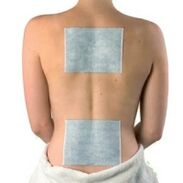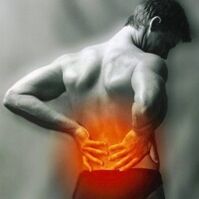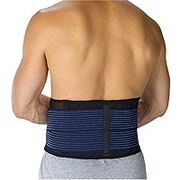
Back pain is a fairly common phenomenon; it is difficult to find a person who does not face this problem.
Characteristic is also the eternal problem of "lack of time" to go to the doctor, according to which most people prefer self-medication, for which they use gels and oils actively advertised that eliminate back pain.
Along with these tools, plaster is actively advertised. This medicine for backpack treatment has been known for a long time, but in recent years it did not enjoy much popularity until the big manufacturers took it.
To understand if such patches are really effective, one must understand the possible causes of back pain.
Why does my back hurt?
Back pain can have many causes. The most harmless of these are minor injuries and sprains that a person can get during sports and during physical work.
Although, in the absence of proper attention to such minor injuries, they can have very unpleasant "delayed" consequences, affecting the condition of the muscular corset of the back and the musculoskeletal system itself.

But in the general case, such minor injuries remind themselves of the pain for a few days, after which they gradually disappear.
But the most common cause of severe back pain is osteochondrosis and its consequences.
This disease is dangerous because it develops gradually and in the early stages, when it can still be successfully treated, does not appear with any practical symptoms.
In the future, it is this disease that becomes the cause of the development of various pain syndromes, the formation of intervertebral hernias, etc.
If microtraumas of the back can still be ignored while waiting for the moment when they stop causing pain, then it will not work with osteochondrosis - when its consequences appear, it is not possible to cope with severe pain for a long time and still have togo to the doctor.
In addition, if minor injuries are successfully eliminated with improvised means, then serious back diseases should be treated for years.
The main cause of pain in this disease is damage to the nerve roots of the spinal cord. Such compression can occur for a variety of reasons, but it is this compression that causes almost all pain syndromes.
Warming effect in the treatment of back pain

When treating back injuries or diseases, doctors almost always recommend "dry heat" along with the necessary medication.
This usually means wrapping the affected part of the body with a warm fluffy scarf - so that the back in the affected area is "warm" well.
This "dry heat" improves blood circulation, due to which inflammation and edema are reduced to some extent, which leads to a decrease in pressure at the root of the compressed nerve.
Therefore, the pain syndrome is reduced. Of course, this method in itself will not face severe pain, but it is quite suitable as a kind of aid.
Moreover, it can be observed that the vast majority of popular recipes for back pain are based precisely on this warming effect of the affected back area. And with not too strong pain, such methods cope successfully, although they do not allow you to get rid of the cause of their appearance.
Heating as an alternative to tablets
When back pain occurs, doctors usually give priority to medication. And such methods in most cases involve the use of non-steroidal anti-inflammatory drugs, which quickly relieve inflammation and reduce pain.
Therefore, NSAIDs mainly pursue one goal - to reduce the pain, which they in most cases successfully cope with.
But such drugs have a serious drawback - the treatment of back diseases involves a very long use of them, in which side effects begin to appear.
The most common of these effects is disruption of the gastrointestinal tract. Thus, for example, treatment of a disc herniation can take up to a year, and taking NSAIDs without significant consequences for the patient's body can rarely take more than a month.
This leads to the fact that doctors are forced to prescribe such drugs in minimal effective doses and seek alternative methods of treatment.
First of all, they pay attention to gels and oils, which are in large quantities in pharmacies.
But half of them in this case are not suitable, as all their effect is based on the action of the same NSAIDs. Ointments of a "warming" nature are much more expensive and less common.
Another popular alternative now is plaster, which is invisible, bonds well to the back, and relieves back pain quite effectively.
Types of backs
Suva speci
The oldest and "deserved" is the banal plaster with pepper, which has been known for a very long time. The principle of action is simple and clear - a special speci composition is applied to the adhesive surface, which has an irritating and warming effect when it touches the skin.
Probably the only drawback of such a patch is the excessive aggressiveness of the spice, which, in the slightest violation of the rules for the use of the piece, can lead to serious skin irritation.
And this will seriously limit the treatment options - the inflamed area can not be massaged, it is no longer possible to stick another plaster on it or put a warm gel or oil.
These shortcomings have become the reason for the search for alternative heating compounds that will be applied to the plot with no less efficiency.
Anesthetic without heat - NSAID Patch
Some manufacturers, without further ado, decided to bypass the problem of skin irritation simply and gracefully - the same non-steroidal anti-inflammatory drugs are simply applied to the patches, which are gradually absorbed into the skin and have their therapeutic effect.
Thanks to this patch, back pain is removed fairly quickly, the risk of irritation is minimal and the issue of overheating is also not worth it. But this piece of land also has disadvantages.
For example, they are definitely not suitable for those who prefer to do without "chemistry" if possible, as the main active ingredient is the same as tablets, only it enters the body through the skin, having the same unpleasant side effects.
Reflected heat
Another option is plaster, which contains one or another "reflective" coating. It is not as important as the manufacturer specifically calls it, the essence is the same - the heat released by the human body is reflected and accumulated, due to which a warming effect appears.
Of course, such plasters have practically no contraindications (as there is no active substance), but it is better to stick them not on the skin, but on linen.
"Miracle Plaster" from China
There are a number of types of patches that have been developed in China based on traditional local medicine. The composition of such a plot contains many herbal ingredients, each of which (in theory) should have a certain therapeutic effect.
Such a plot is a very good choice for lovers of "natural" treatment, its only drawback is its unconfirmed effectiveness.



































